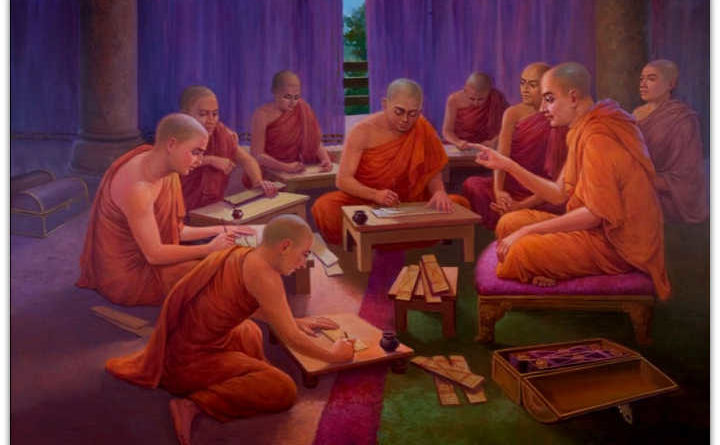Nội Dung Chính
Pali Versions : Pali-English and Pali-Devanagri versions are provided in every section of version 2 texts.
Introduction: The Anguttara Nikaya (“Collection of Gradual Discourses”) is the fourth of the five nikayas (collections) in the Sutta Pitaka. Anguttara Nikaya contains suttas spoken by Buddha in numerical order i.e. Books of Ones contains teachings for each one subject whereas Book of Twos contains teachings for two subjects and so on. However on closer inspection it is seen that initial books contain simple topics of everyday nature whereas the later books contain higher topics & final chapters contain topics for trance states and meditation in explanatory manner. Therefore Anguttara Nikaya gradually deals from observable mundane phenomena to higher & higher ones step by step. Another great thing about Anguttara Nikaya is that it contains all the knowledge which Buddha wants to convey and also in a simple manner. Hence it is recommended that Anguttara Nikaya be read from beginning to end continuously without gaps or jumps and upto the very final chapters. Efforts have been made to keep the meanings as close to originally intended, however, for complete understanding of transcendental/divine aspects, reading of Pali version along with practice of meditation is required for true meaning. Pali can be considered as a language for spiritual awakening.
Some of the Important Suttas are :
2:4.2 Repaying One’s Parents;3.16 Self-restraint; 3.61 Four Great Truths
4:23 What is a Tathagata (Buddha;Fully Enlightened One)?; 5:23 Psychic powers from cleaning the mind; 5:24 Immoral Path, bad effects of immorality i.e breaking celibacy etc; 5:28 Five Factored Samadhi explained in detail (also in 2:26, 5:27); 5:75 & 5:76 Brahmachari is like Warrior (Yodhajiva); 5.192 What is a Brahmin; 5.211 Five dangers from Insulting the Monks/Holy; 6.2 Supernatural Powers; 6.18 Non-Violence; 6.60 Hatthi : Samadhi state can also be lost; 6.63 How Buddha can know other’s minds; 7.49 Perceptions (sanna) How to develop detachment; 7.50 & 7.51 Sex; 7.55 Destinations ; on nibbana; 7.56 Tissa ; A lecture on brahmas & their knowledge; 7.61 Drowsiness , laziness, how to cope; 7.62 Metta/compassion leads to brahma world; 7.64 Anger ; 7.66 Destruction of the world ; 7.71 Development of the student; 7.72 Fire (for immorality); 7.74 Short is human life; 8.11 Like a chick breaking eggshell; 8.36 Kiriya phala (Karma); 8.40 Results bad actions; 8.41 & 8.42 Uposatha; 8.46 Devata (deities); 8.47 A good wife; 8.64, 8.65, 8.66 Process of Awakening; 9.18-9.19 Uposatha & devata; 9.21 About India (Jambudipa); 9.27 Conditions for stream entry; 9.31 Effects of Jhana/Samadhi; 9.32 & 9.33 & 9.36 Nine Jhana states; 9.34 Nibbana is happiness/bliss; 9.39 How to defeat Mara, the evil one; 9.41 Enlightenment process in detail; 10:21 What are ten powers of Buddha?; 10.29 Universe; 10.46 Benefits of uposatha(fast) & meditation; 10.60 Impermanence & Detailed Anapana; 10.61 Avijja; 10.69 & 10.70 Ten types Talks allowed to monks; 10.89 Blaming saints falsely – Kokalika see 11.6 Disaster; 10.97 Ahuneyya-who is great; 10.99 Upali-How to practice; 10.170 Near shore & Far shore; 10.176 Purity;10.177 Donation for dead; 10.216, 10.219 Karma & rebirth; 10.217-10.218 karma; 11.1-11.3 Importance of Sheel (morality); 11.9 Samadhi state:A meditating person is worshipped by Indra, Brahma & devtas; 11.10 The Kshatriya are best – Say Brahma Sanatkumara; 11.11 How to meditate (in detail); 11:16 The Benefits of Metta/compassion; 11.17 Cowherd : How to practice Buddhism
Contents
Anguttara Nikaya Ver.2-New & Complete
AN1.The Book of Ones-ver2
AN2.The Book of Twos-ver2
AN3.The Book of Threes-ver2
AN4.The Book of Fours-ver2
AN5.The Book of Fives-ver2
AN6.The Book of Sixes-ver2
AN7.The Book of Sevens-ver2
AN8.The Book of Eights-ver2
AN9.The Book of Nines-ver2
AN10.The Book of Tens-ver2
AN11.The Book of Elevens-ver2
Changes to Bhikku B.Bodhi’s Version & Their Explanations
Anguttara Nikaya Verse by Verse Translation
AN1-The Book of Ones-Verse by Verse
Anguttara Nikaya Ver.1-Old & Incomplete
Download/View English Translation
1. Modified version of Bhikku Bodhi’s translation in order to keep the meaning as close to original, with many Pali words included so that monks & meditators can also benefit from it.
File:Anguttara-Nikaya-mod-web.pdf
2. Translation by Bhikku Bodhi. However this is as per western understanding and needs thorough support of Pali version side by side in order to understand actual meaning. The entire book is divided into 7 parts due to max. upper limit of 10mb upload.
File:Anguttara Nikaya Bhikku Bodhi1.pdf
File:Anguttara Nikaya Bhikku Bodhi2.pdf
File:Anguttara Nikaya Bhikku Bodhi3.pdf
File:Anguttara Nikaya Bhikku Bodhi4.pdf
File:Anguttara Nikaya Bhikku Bodhi5.pdf
File:Anguttara Nikaya Bhikku Bodhi6.pdf
File:Anguttara Nikaya Bhikku Bodhi7.pdf
3. Very old translation from Pali Text Society(PTS). Cannot be relied upon, so it is better to read other versions.
Note : Some files are divided into parts a,b,c etc.due to max. upper limit of 10mb upload.
File:AN1.pts.pdf ; File:AN2.pts.pdf ; File:AN3.pts.pdf ; File:AN4.pts.pdf
File:AN5.pts a.pdf ; File:AN5.pts b.pdf
Original Pali Version
(From www.tipitaka.org)
Click the link below to access the original Anguttara Nikaya files in Pali language, the language spoken by Buddha.

